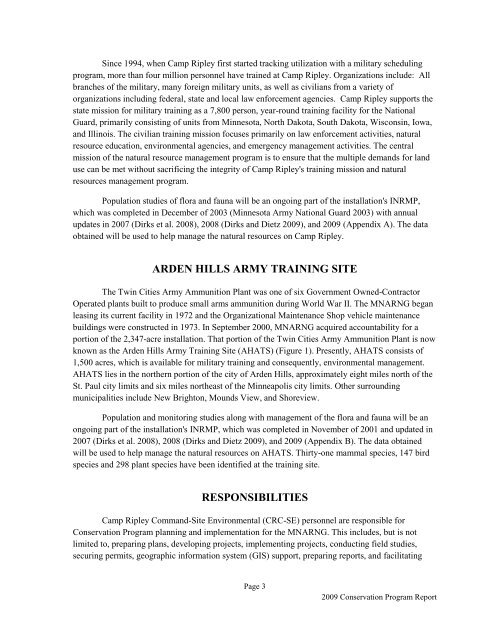camp ripley and arden hills minnesota army national guard training ...
camp ripley and arden hills minnesota army national guard training ...
camp ripley and arden hills minnesota army national guard training ...
Create successful ePaper yourself
Turn your PDF publications into a flip-book with our unique Google optimized e-Paper software.
Since 1994, when Camp Ripley first started tracking utilization with a military scheduling<br />
program, more than four million personnel have trained at Camp Ripley. Organizations include: All<br />
branches of the military, many foreign military units, as well as civilians from a variety of<br />
organizations including federal, state <strong>and</strong> local law enforcement agencies. Camp Ripley supports the<br />
state mission for military <strong>training</strong> as a 7,800 person, year-round <strong>training</strong> facility for the National<br />
Guard, primarily consisting of units from Minnesota, North Dakota, South Dakota, Wisconsin, Iowa,<br />
<strong>and</strong> Illinois. The civilian <strong>training</strong> mission focuses primarily on law enforcement activities, natural<br />
resource education, environmental agencies, <strong>and</strong> emergency management activities. The central<br />
mission of the natural resource management program is to ensure that the multiple dem<strong>and</strong>s for l<strong>and</strong><br />
use can be met without sacrificing the integrity of Camp Ripley's <strong>training</strong> mission <strong>and</strong> natural<br />
resources management program.<br />
Population studies of flora <strong>and</strong> fauna will be an ongoing part of the installation's INRMP,<br />
which was completed in December of 2003 (Minnesota Army National Guard 2003) with annual<br />
updates in 2007 (Dirks et al. 2008), 2008 (Dirks <strong>and</strong> Dietz 2009), <strong>and</strong> 2009 (Appendix A). The data<br />
obtained will be used to help manage the natural resources on Camp Ripley.<br />
ARDEN HILLS ARMY TRAINING SITE<br />
The Twin Cities Army Ammunition Plant was one of six Government Owned-Contractor<br />
Operated plants built to produce small arms ammunition during World War II. The MNARNG began<br />
leasing its current facility in 1972 <strong>and</strong> the Organizational Maintenance Shop vehicle maintenance<br />
buildings were constructed in 1973. In September 2000, MNARNG acquired accountability for a<br />
portion of the 2,347-acre installation. That portion of the Twin Cities Army Ammunition Plant is now<br />
known as the Arden Hills Army Training Site (AHATS) (Figure 1). Presently, AHATS consists of<br />
1,500 acres, which is available for military <strong>training</strong> <strong>and</strong> consequently, environmental management.<br />
AHATS lies in the northern portion of the city of Arden Hills, approximately eight miles north of the<br />
St. Paul city limits <strong>and</strong> six miles northeast of the Minneapolis city limits. Other surrounding<br />
municipalities include New Brighton, Mounds View, <strong>and</strong> Shoreview.<br />
Population <strong>and</strong> monitoring studies along with management of the flora <strong>and</strong> fauna will be an<br />
ongoing part of the installation's INRMP, which was completed in November of 2001 <strong>and</strong> updated in<br />
2007 (Dirks et al. 2008), 2008 (Dirks <strong>and</strong> Dietz 2009), <strong>and</strong> 2009 (Appendix B). The data obtained<br />
will be used to help manage the natural resources on AHATS. Thirty-one mammal species, 147 bird<br />
species <strong>and</strong> 298 plant species have been identified at the <strong>training</strong> site.<br />
RESPONSIBILITIES<br />
Camp Ripley Comm<strong>and</strong>-Site Environmental (CRC-SE) personnel are responsible for<br />
Conservation Program planning <strong>and</strong> implementation for the MNARNG. This includes, but is not<br />
limited to, preparing plans, developing projects, implementing projects, conducting field studies,<br />
securing permits, geographic information system (GIS) support, preparing reports, <strong>and</strong> facilitating<br />
Page 3<br />
2009 Conservation Program Report
















